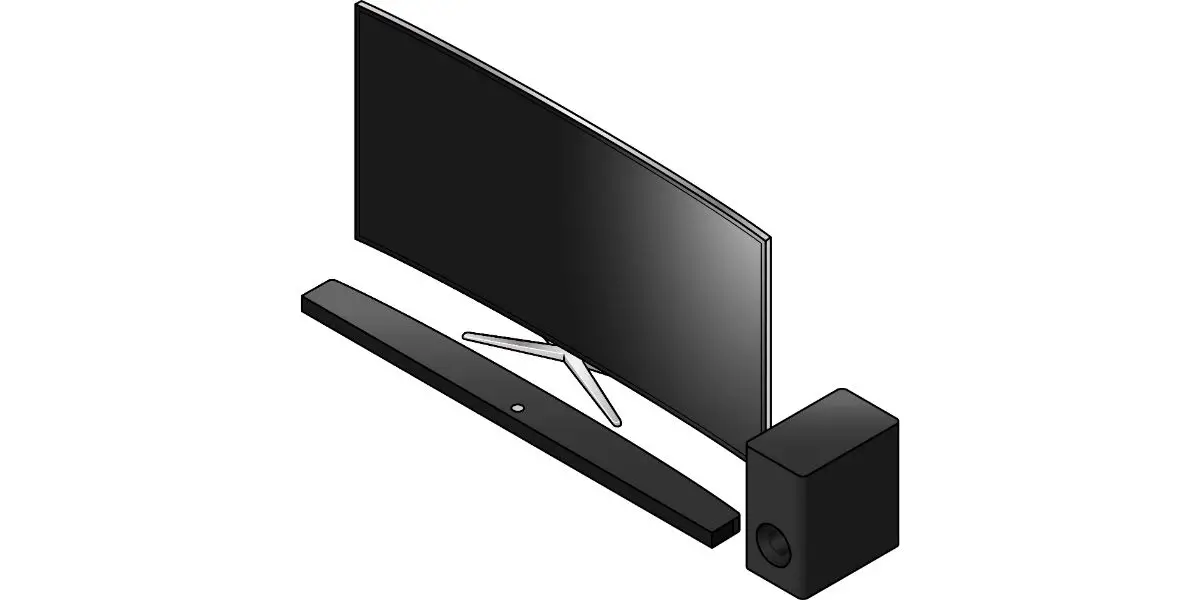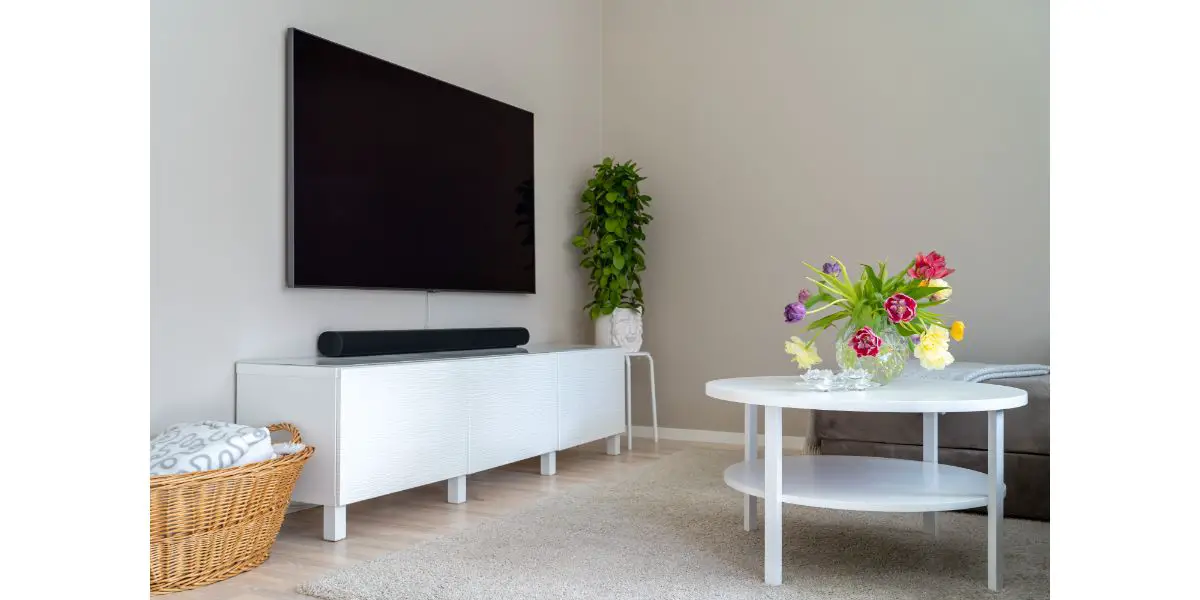Disclaimer: This post may contain affiliate links, meaning we get a small commission if you make a purchase through our links, at no cost to you. For more information, please visit our Disclaimer Page.
Soundbars became a hit when potential consumers discovered their usefulness as affordable home theater alternatives. The fact that they are long, narrow, and easily fit into an entertainment setup certainly helps. But what happens when your preferred spot (just below the TV) just isn’t working out?
The beauty of a soundbar is in its versatility. While placing it under the TV is ideal, it’s not the only spot you can install it. You can install it above the TV, Inside some cabinetry, raise your TV to make room, or place it behind your TV.
The thing to remember with soundbars is the closer they are lined up with the same level as your ears, the better. However, that doesn’t mean your soundbar won’t sound fantastic a foot below your ear level or above the TV. One thing is for sure, you can just about mount it in water and get better audio output than your TV’s factory speakers.
Table of Contents
4 Tips on What to Do When Soundbar Won’t Fit Under TV
1. Raising Your TV
Everybody has their own, preferred setup. Maybe this isn’t an option for you but if you have a little wiggle room in terms of north and south on your wall, raising the TV is a good option. This is especially true if you can switch from a low-lying entertainment setup to a wall mount.
The fact is, most soundbars wall mount as well. If you have a wall mount that fits your TV and you can wall mount your soundbar, you open up a world of possibilities in exactly how you want your setup to look and provide the best entertainment.
Some wall mounts are adjustable and not just to the left or the right. Some will let you shift the TV up and down as well. If not, just be sure to install the wall mount high enough that there will be plenty of space below the TV.
Do this by taking exact measurements of your TV, using the wall mount as a center. Measure from below where the bottom of the TV will be to the floor and know how tall anything is that’s going to go underneath the TV, leaving plenty of room for a slim soundbar.
If your TV is sitting on a flat cabinet surface, consider purchasing a raised pedestal mount. These things work very similarly to a wall mount. They screw into the center-rear section of the TV, with a pedestal that props the TV up much higher on the cabinet’s surface.
This should raise your TV high enough that placing a soundbar beneath it is feasible. In fact, these low-level surfaces on small entertainment centers are excellent for placing soundbars.
They tend to be very close to ear-level and you don’t have to purchase a bunch of additional mounting hardware for the soundbar.
2. Place it Behind Your TV
We’ll be absolutely honest—this is not the most ideal solution. This is the route you take when you have no other options at all. For one, the TV will deflect audio back and away from you.
You also run the risk that your soundbar remote won’t be able to communicate with the TV, forcing you to get up and manually adjust the volume anytime you want to change it. Last but not least, in a multi-speaker setup (3.1, 5.1, and 7.1 systems), the TV will muffle a primary component of the audio.
While it can work or you can make it work, it’s not the ideal setup for your soundbar. If you have to install it behind the TV, it should only be because you simply have no other choice, and it’s the best alternative at your disposal.
If there is any way you can angle the soundbar so that it’s mounted just behind the bottom or top of the TV, you can take advantage of bouncing the sound off the ceiling or the floor.
It won’t give you a huge audio improvement but it will be noticeably better than what you would have otherwise.
3. Placing it Above Your TV
This is a far more suitable option. It’s not as good as situating the soundbar below your TV but it’s much better than placing it behind your TV. The biggest drawback to the above-TV scenario is that your soundbar probably won’t be level with your ears.
This just means you won’t get the maximum audio effect from the soundbar. Fortunately, it won’t kill the entire thing, especially if you have a multi-speaker setup and your soundbar is nothing more than a dialogue box.
You need to install the soundbar high enough above the TV so that no part of the TV is blocking the audio from reaching the audience in front of it.
If you can purchase a flexible mount for your soundbar, you can even angle it downward to get some of the effects you lose from not having it at ear level.
Plus, the closer the TV is to being flush with the wall, the easier it will be to direct the audio from the soundbar where it needs to go. Another option you should look into is investing in an upward-firing soundbar.
These soundbars use the reflective nature of your ceiling to bounce audio back down on you. With these kinds of soundbars, you don’t have to worry as much about how far the TV sticks out from the wall.
In fact, you can just about have your soundbar hidden above the TV, so long as the audio has an unobstructed pathway to the ceiling.
4. Place the Soundbar In Your Entertainment Center Cabinet
Again, the biggest risk you run with this option is muffling the sound. You also run the risk of creating a rattling vibration noise, especially if your soundbar has a good deal of bass to it. It also depends on the structure of the cabinet and entertainment center, and how the speakers inside your soundbar are directed.
Upward and downward-firing speakers may have a funny sound to them, buried inside of a cabinet. With the audio striking the inside of the cabinet first, it’s liable to muffle the sound or remove the richness and detail from the audio.
If your cabinet opens up wide, providing forward-firing speakers with an unobstructed pathway to the area where everyone will be, that’s the best setup you can get from such an arrangement.
If the speakers are upward-firing, and you have no other choice but to place the soundbar in the cabinet, do your best to keep the soundbar as close to the cabinet opening as possible.
Also, do your best to ensure there is as much space as possible between the speakers and the interior of the cabinet.
Of course, if you’re dealing with a very tall entertainment center, it may work out great to have the upper portion of the cabinet providing a good reflection point for the audio to strike and travel down, into the room.
The point is, placing a soundbar in a cabinet is workable, especially if you have a few options inside the cabinet.
Final Thoughts Soundbar
The slim profile of soundbars allows you some wiggle room when you just can’t cram it in underneath the TV. Wall mounts that pivot up and down also help you direct the audio in an ideal manner, even when you’re forced to mount the soundbar in a less-than-ideal place.
The best soundbar setup depends on the layout of your room and where everyone sits in relation to the TV. While there are only so many places you can feasibly place a soundbar, they are far easier to fiddle with than massive home theater setups and even the worst positioning still provides decent audio.
Meta Description
Having trouble fitting your soundbar under the TV? Discover solutions and practical tips in this article to overcome space constraints and optimize your audiovisual setup effortlessly.
Reference Sources
Having trouble fitting a soundbar in with my TV Retrieved from: https://www.avforums.com/threads/having-trouble-fitting-a-soundbar-in-with-my-tv.2232261/ Looking for a soundbar to actually fit under my TV Retrieved from:


